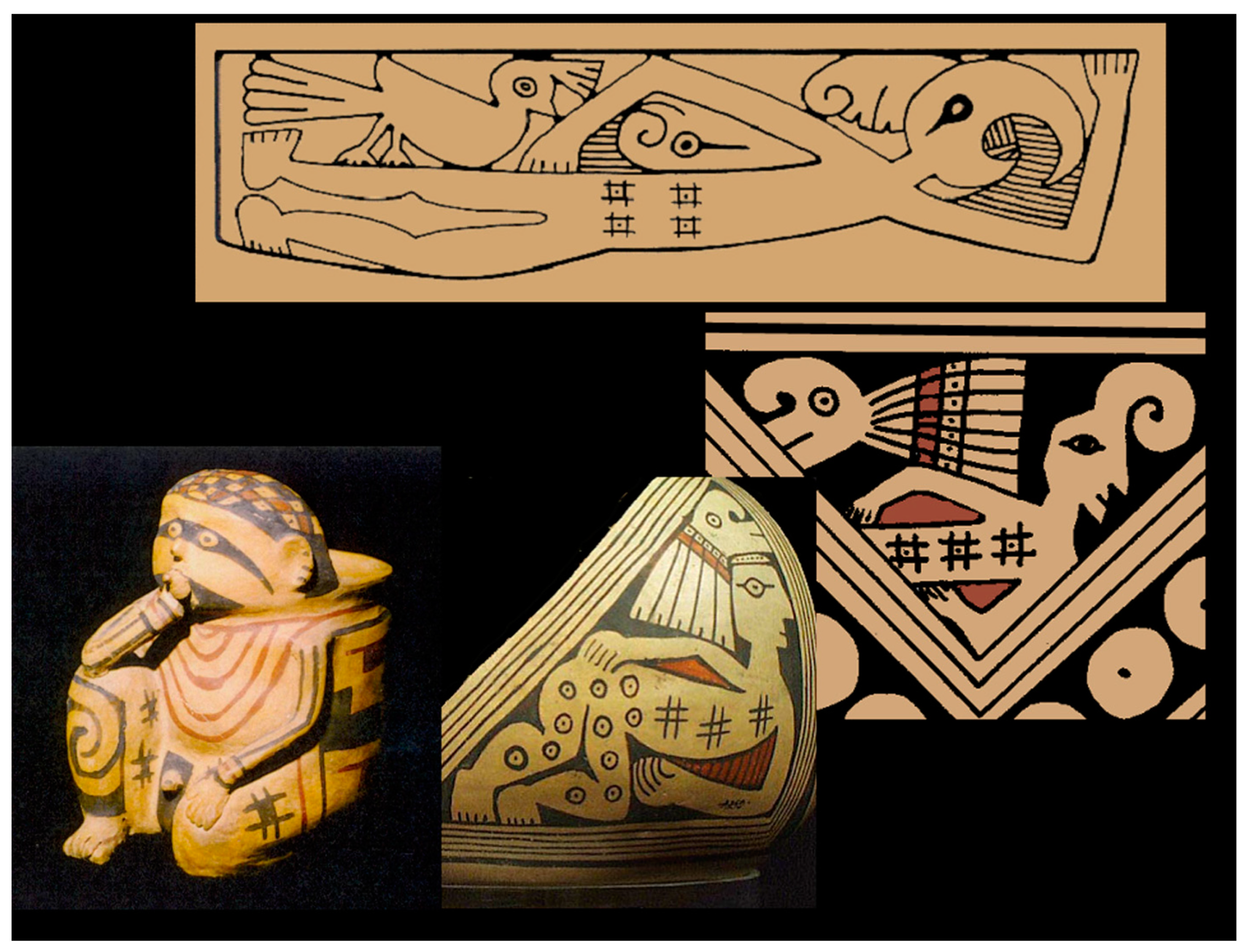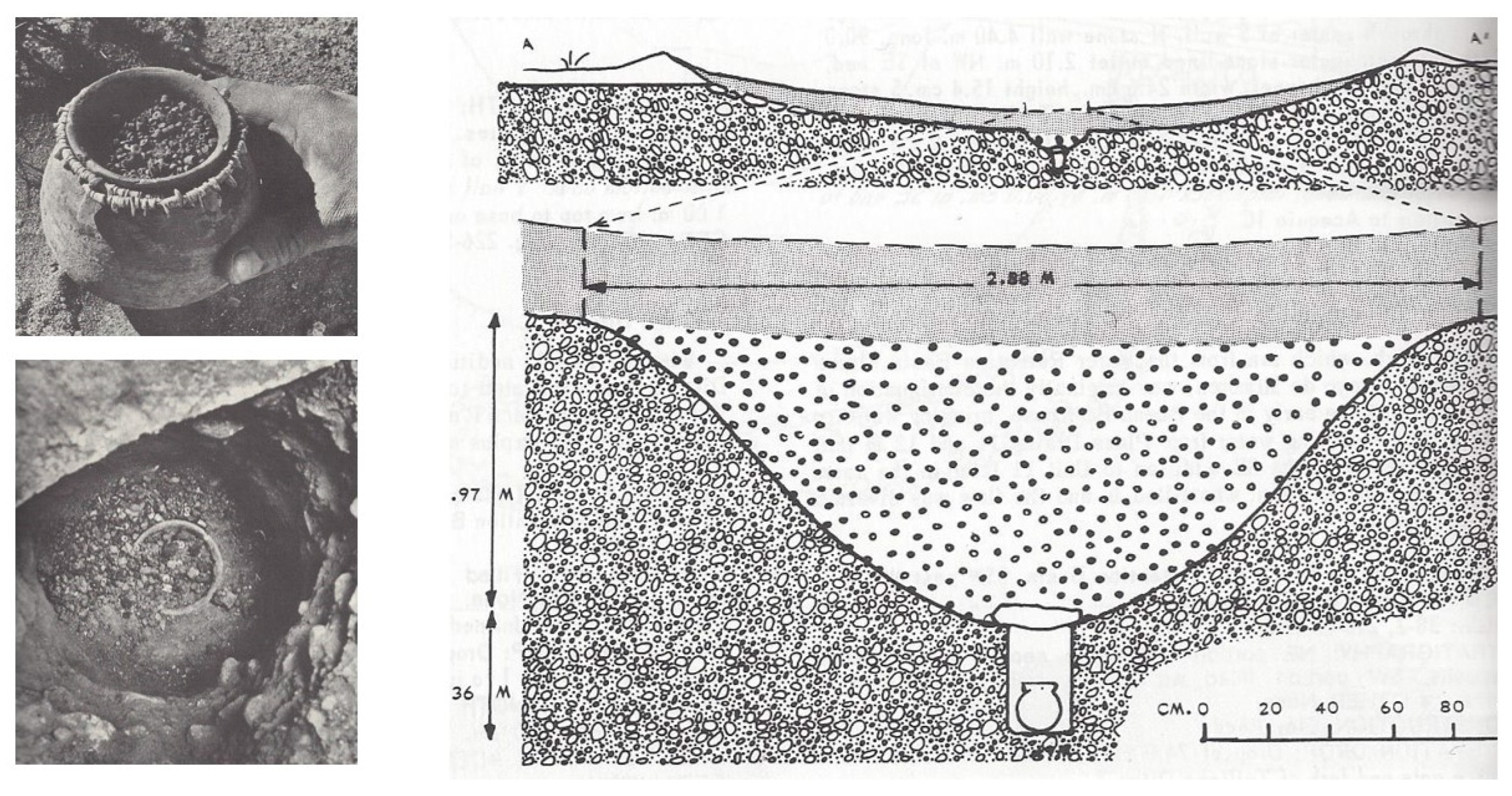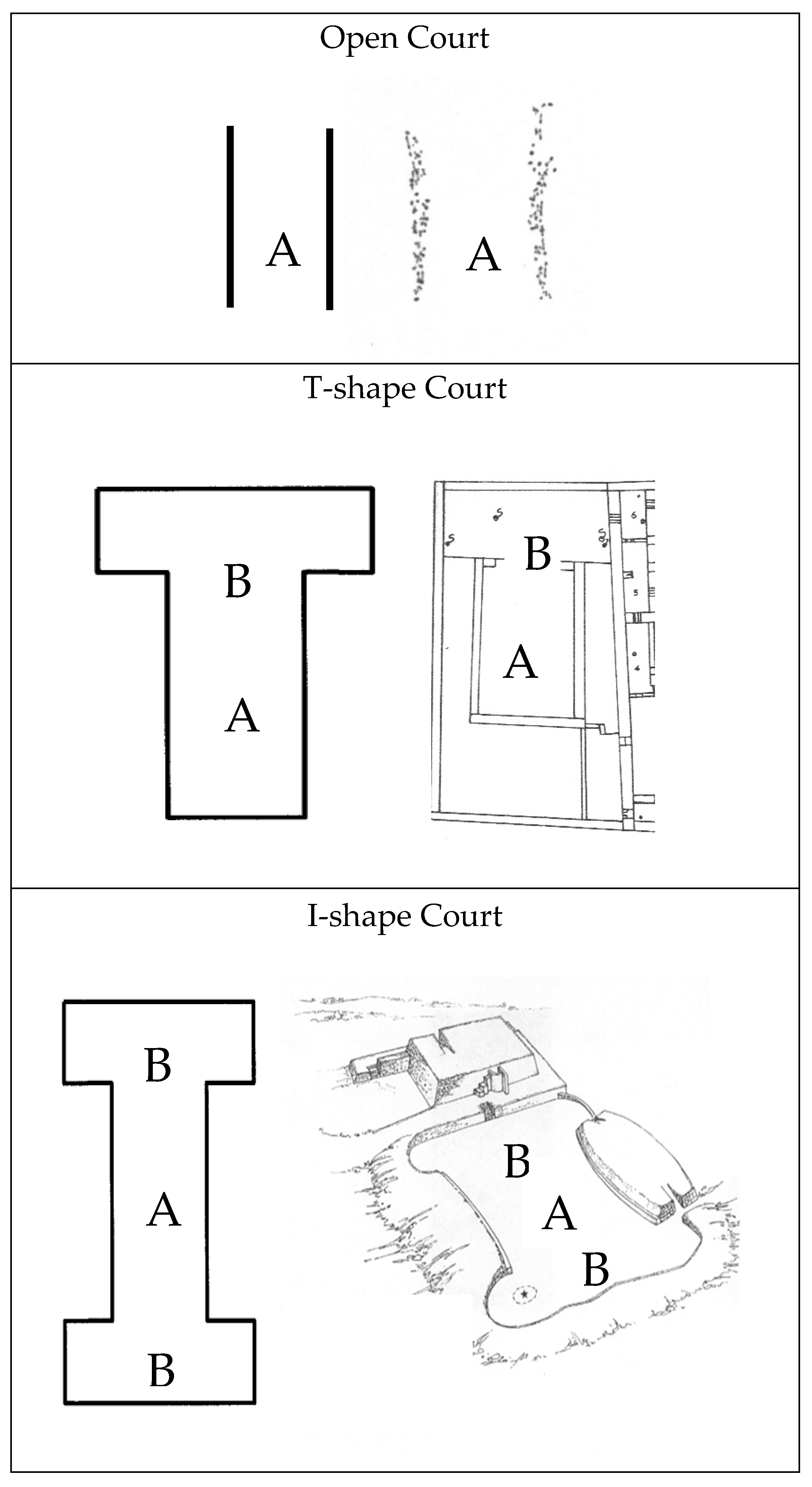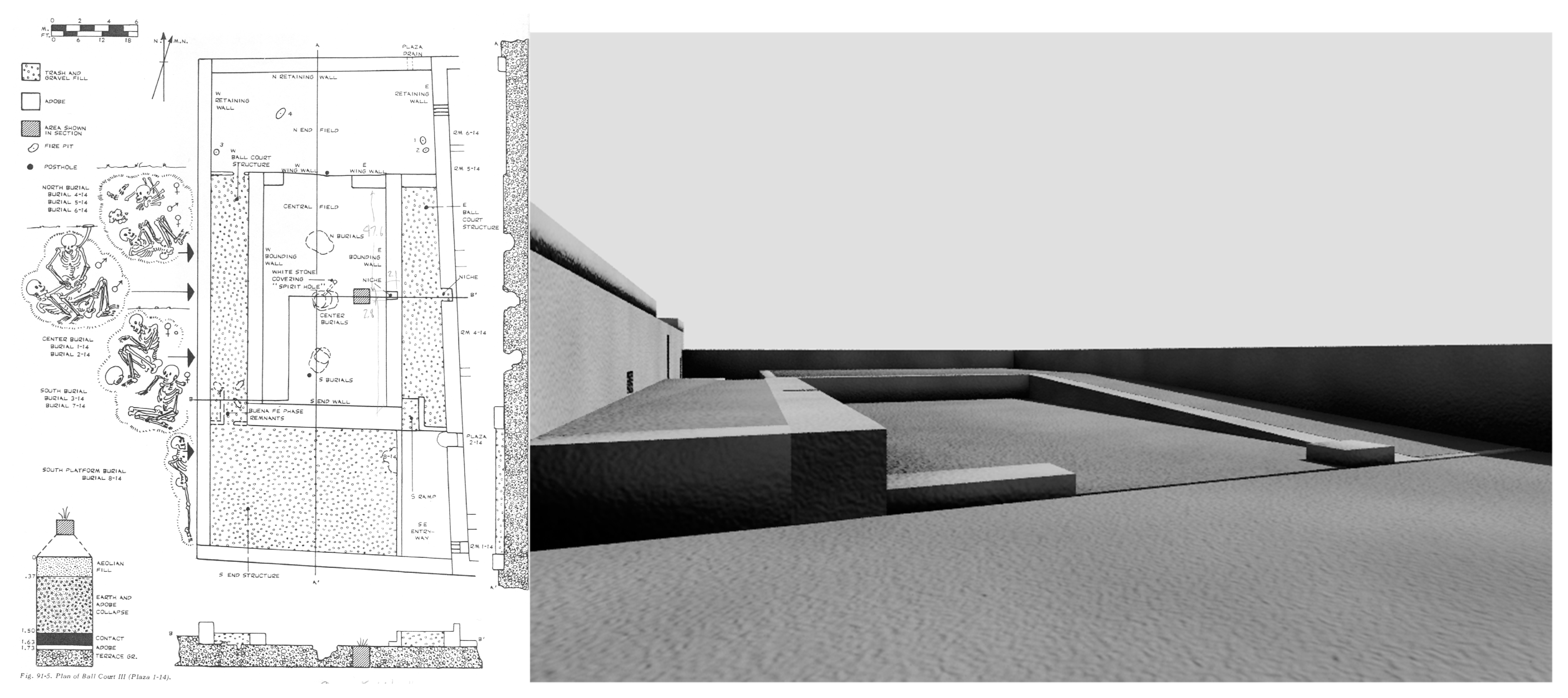Bringing the Inert to Life: The Activation of Animate Beings
Abstract
1. Introduction
2. Background
2.1. The Birth of Made Beings
- We made our plume wands into living beings.
- With the flesh of our mother,
- Clay Woman,
- Four times clothing our plume wands with flesh,
- We made them into living beings.
- Holding them fast,
- We made them our representatives in prayer.
The animals and things which might become guardian spirits were almost limitless, including the weather, dwarfs, the nipple of a gun, horseflies, kettles, and objects referring to death. But very nearly all the natural phenomena of the world were distinctive as guardian spirits of one or other profession. Shamans, warriors, fishermen, hunters, and gamblers had each their recognizable guardians.
2.2. Casas Grandes Medio Period Ontology and Cosmology
3. Case Study: Activating Object-Persons at Paquimé
4. Discussion and Conclusions
Author Contributions
Funding
Data Availability Statement
Acknowledgments
Conflicts of Interest
References
- Beaglehole, Ernest, and Pearl Beaglehole. 1937. Notes on Hopi Economic Life. New Haven: Yale University Press. [Google Scholar]
- Benedict, Ruth F. 1923. The Guardian Spirit in North America. Memoirs of the American Anthropological Association Number 29. Washington, DC: American Anthropological Association. [Google Scholar]
- Bird-David, Nurit. 1999. Animism Revisited: Personhood, Environment, and Relational Epistemology. Current Anthropology 40s: S67–S91. [Google Scholar] [CrossRef]
- Blomster, Jeffrey P., and Víctor E. Salazar Chávez. 2020. Origins of the Mesoamerican Ballgame: Earliest Ballcourt from the Highlands found at Etlatongo, Oaxaca, Mexico. Science Advances 6: eaay6964. [Google Scholar] [CrossRef] [PubMed]
- Bonvillain, Nancy. 2001. Native Nations: Culture and Histories of Native North Americans. Upper Saddle River: Prentice Hall. [Google Scholar]
- Bunzel, Ruth L. 1992. Zuni Ceremonialism: Three Case Studies. Albuquerque: University of New Mexico Press. First published 1932. [Google Scholar]
- Chaniotis, Angelos. 2017. The Life of Statues of Gods in the Greek World. études 30: 91–112. [Google Scholar] [CrossRef]
- Cunningham, Jerimy J. 2017. The Ritual Mode of Production in the Casas Grandes Social Field. In Modes of Production and Archaeology. Edited by Robert M. Rosenswig and Jerimy J. Cunningham. Gainesville: University Press of Florida, pp. 174–206. [Google Scholar]
- Day, Jane Stevenson. 2001. Performing on the Court. In The Sport of Life and Death: The Mesoamerican Ballgame. Edited by E. Michael Whittington. New York: Thames and Hudson, pp. 64–77. [Google Scholar]
- Di Peso, Charles C., John B. Rinaldo, and Gloria J. Fenner, eds. 1974. Casas Grandes: A Fallen Trading Center of the Grand Chichimeca. Dragoon: Amerind Foundation, Flagstaff: Northland Press, vols. 2–8. [Google Scholar]
- Douglas, John E., and A. C. MacWilliams. 2015. Society and Polity in the Wider Casas Grandes Region. In Ancient Paquimé and the Casas Grandes World. Edited by Paul E. Minnis and Michael E. Whalen. Tucson: University of Arizona Press, pp. 126–47. [Google Scholar]
- Dunning, Nicholas P. 2020. Life and Death from the Watery Underworld: Ancient Maya Interaction with Caves and Cenotes. In Sacred Waters: A Cross-Cultural Compendium of Hallowed Springs and Holy Wells. Edited by Celeste Ray. Oxford: Routledge, pp. 50–58. [Google Scholar]
- Dye, David. 2020. Anthropomorphic Pottery Effigies as Guardian Spirits in the Lower Mississippian Valley. In Cognitive Archaeology: Mind, Ethnography, and the Past in South Africa and Beyond. Edited by David S. Whitley, Johannes H. N. Loubser and Gavin Whitelaw. London: Routledge, pp. 201–23. [Google Scholar]
- Evans, Susan T. 2004. Ancient Mexico and Central America: Archaeology and Culture History. London and New York: Thames and Hudson Ltd. [Google Scholar]
- Fogelin, Lars, and Michael B. Schiffer. 2015. Rites of Passage and Other Rituals in the Life Histories of Objects. Cambridge Archaeological Journal 25: 815–27. [Google Scholar] [CrossRef]
- Ford, Richard I. 2020. Sacred Springs of the Tewa Pueblos, New Mexico. In Sacred Waters: A Cross-Cultural Compendium of Hallowed Springs and Holy Wells. Edited by Celeste Ray. Oxford: Routledge, pp. 131–37. [Google Scholar]
- Fox, John Gerard. 1996. Playing with Power: Ballcourts and Political Ritual in Southern Mesoamerica. Current Anthropology 37: 483–96. [Google Scholar] [CrossRef]
- Frisbie, Charlotte Johnson. 1970. The Navajo House Blessing Ceremonial: A Study of Cultural Change. Ph.D. dissertation, The University of New Mexico, Department of Anthropology, Albuquerque, NM, USA. [Google Scholar]
- Frisbie, Charlotte Johnson. 1980. Ritual Drama in the Navajo House Blessing Ceremony. In Southwestern Indian Ritual Drama. Albuquerque: University of New Mexico Press. Available online: https://ehrafworldcultures.yale.edu/document?id=nt13-297 (accessed on 15 December 2022).
- Gillespie, S. D. 1991. Ballgames and Boundaries. In The Mesoamerican Ballgame. Edited by V. L. Scarborough and David R. Wilcox. Tucson: The University of Arizona Press, pp. 317–45. [Google Scholar]
- Hallowell, A. Irving. 1960. Ojibwa Ontology, Behavior, and World View. New York: Columbia University Press. [Google Scholar]
- Harmon, Marcel. 2005. Centralization, Cultural Transmission, and “The Game of Life and Death” in Northern Mexico. Ph.D. dissertation, Department of Anthropology, University of New Mexico, Albuquerque, NM, USA. [Google Scholar]
- Harmon, Marcel. 2006. Religion and the Mesoamerican Ballgame in the Casas Grandes region of Northern Mexico. In Religion in the Prehispanic Southwest. Edited by Christine S. VanPool, Todd L. VanPool and David A. Phillips, Jr. Lanham: AltaMira Press, pp. 185–217. [Google Scholar]
- Harmon, Marcel. 2008. The “Game of Life and Death: ” within the Casas Grandes Region of Northern Mexico. In Touching the Past: Ritual, Religion, and Trade of Casas Grandes. Edited by Glenna Nielsen-Grimm and Paul Stavast. Provo: Museum of Peoples and Culture, Brigham Young University, pp. 29–46. [Google Scholar]
- Hays-Gilpin, Kelley, and Jane H. Hill. 1999. The Flower World in Material Culture: An Iconographic Complex in the Southwest and Mesoamerica. Journal of Anthropological Research 55: 1–37. [Google Scholar] [CrossRef]
- Hays-Gilpin, Kelley, and Jane H. Hill. 2000. The Flower World in Prehistoric Southwest Material Culture. In The Archaeology of Regional Interaction. Edited by Michelle Hegmon. Boulder: University Press of Colorado, pp. 411–28. [Google Scholar]
- Hill, Jane H. 1992. The Flower World of Old Uto-Aztecan. Journal of Anthropological Research 48: 117–44. [Google Scholar] [CrossRef]
- Huckell, Lisa W., and Christine S. VanPool. 2006. Toloatzin and Shamanic Journeys: Exploring the Ritual Role of Sacred Datura in the Prehistoric Southwest. In Religion in the Prehispanic Southwest. Edited by Christine S. VanPool, Todd L. VanPool and David A. Phillips, Jr. Lanham: AltaMira Press, pp. 147–64. [Google Scholar]
- Kendall, Laurel. 2021. Gods and Things: Is “Animism” an Operable Concept in Korea? Religions 12: 283. [Google Scholar] [CrossRef]
- Krug, Andrew. 2018. Pilgrimages Through the Desert: Isotopic Provenance of 76 Draw (LA 156980) Marine Shell Artifacts. Master’s thesis, Department of Anthropology, University of Missouri, Columbia, MO, USA. [Google Scholar]
- Leyenaar, Ted J. J. 2001. The Modern Ballgames of Sinaloa: A Survival of the Aztec Ullamaliztli. In The Sport of Life and Death the Mesoamerican Ballgame. Edited by Michael Whittington. London: Thames & Hudson, Ltd., pp. 122–29. [Google Scholar]
- López, Angel Gonzálax, and Lirena Vázquez Vallín. 2021. The Flower World in Tenochtitlan: Sacrifice, War, and Imperialistic Agendas. In Flower Worlds: Religion, Aesthetics, and Ideology in Mesoamerica and the American Southwest. Edited by Michael D. Mathiowetz and Andrew D. Turner. Tucson: The University of Arizona Press, pp. 243–65. [Google Scholar]
- Lucero, Lisa J., and Andrew Kinella. 2015. Pilgrimage to the Edge of the Watery Underworld: An Ancient Maya Water Temple at Cara Blanca, Belize. Cambridge Archaeological Journal 25: 163–85. [Google Scholar] [CrossRef]
- Magliocco, Sabina. 2018. Folklore and the Animal Turn. Journal of Folklore Research 55: 1–7. [Google Scholar] [CrossRef]
- Mathiowetz, Michael D., and Andrew D. Turner, eds. 2021. Flower Worlds: Religion, Aestetics, and Ideology in Mesoamerica and the American Southwest. Amerind Studies in Anthropology. Tucson: The University of Arizona Press. [Google Scholar]
- Miller, Mary. 2001. The Maya Ballgame: Rebirth in the Court of Life and Death. In The Sport of Life and Death: The Mesoamerican Ballgame. Edited by E. Michael Whittington. London: Thames & Hudson, pp. 79–87. [Google Scholar]
- Mökkönen, Teemu, Kerkko Nordqvist, and Vesa-Pekka Herva. 2017. Beneath the Surface of the World: High-Quality Quartzes, Crystal Cavities, and Neolithization in Circumpolar Europe. Arctic Anthropology 54: 94–110. [Google Scholar] [CrossRef]
- Pailes, Matthew C., and Michael T. Searcy. 2022. Hinterlands to Cities: The Archaeology of Northwest Mexico and its Vecinos. Washington, DC: Society for American Archaeology Current Perspectives. [Google Scholar]
- Phillips, David A. 1989. Prehistory of Chihuahua and Sonora, Mexico. Journal of World Prehistory 3: 373–401. [Google Scholar] [CrossRef]
- Pongratz-Leisten, Beate. 2021. The Animated Temple and Its Agency in the Urban Life of the City in Ancient Mesopotamia. Religions 12: 638. [Google Scholar] [CrossRef]
- Qu, Feng. 2021. Embodiment of Ancestral Spirits, the Social Interface, and Ritual Ceremonies: Construction of the Shamanic Landscape among the Daur in North China. Religions 12: 567. [Google Scholar] [CrossRef]
- Rakita, Gordon F. M. 2009. Ancestors and Elites: Emergent Complexity and Ritual Practices in the Casas Grandes Polity. Lanham: Altamira. [Google Scholar]
- Rakita, Gordon F. M., and Rafael Cruz. 2015. Organization of Production at Paquimé. In Ancient Paquimé and the Casas Grandes World. Edited by Paul E. Minnis and Michael E. Whalen. Tucson: University of Arizona Press, pp. 58–82. [Google Scholar]
- Reilly, John C. 2021. Christening, Launching, and Commissioning of U.S. Navy Ships. Naval History and Heritage Command. Available online: https://www.history.navy.mil/research/histories/ship-histories/christening-launching-and-commissioning-of-u-s-navy-ships.html (accessed on 5 October 2021).
- Schultes, Richard Evans, Albert Hofmann, and Christian Rätsch. 2001. Plants of the Gods: Their Sacred, Healing, and Hallucinogenic Powers. Rochester: Healing Arts Press. [Google Scholar]
- Sekaquaptewa, Emory, and Dorothy Washburn. 2004. They Go Along Singing: Reconstructing the Hopi Past from Ritual Metaphors in Song and Image. American Antiquity 69: 457–86. [Google Scholar] [CrossRef]
- Simons, Thomas G. 1998. Holy People, Holy Place: Rites for the Church’s House. Chicago: Liturgy Training Publications. [Google Scholar]
- Skibo, James M., Eugene B. McCluney, and William H. Walker, eds. 2001. The Joyce Well Site: On the Frontier of the Casas Grandes World. Salt Lake City: University of Utah Press. [Google Scholar]
- Stark, Barbara L., and Wesley D. Stoner. 2017. Watching the Game: Viewership of Architectural Mesoamerican Ball Courts. Latin American Antiquity 28: 409–30. [Google Scholar] [CrossRef]
- Stevenson, Matilda C. 1904. The Zuni Indians: 23rd Annual Report, 1901–1902 Bureau of American Ethnology. Washington, DC: Smithsonian Institute. [Google Scholar]
- Taladoire, Eric. 2001. The Architectural Background of the Pre-Hispanic Ballgame: An Evolutionary Perspective. In The Sport of Life and Death the Mesoamerican Ballgame. Edited by E. Michael Whittington. London: Thames & Hudson, pp. 96–115. [Google Scholar]
- Topi, John R., Christine S. VanPool, Kyle D. Waller, and Todd L. VanPool. 2018. The Economy of Specialized Ceramic Craft Production in the Casas Grandes Region. Latin American Antiquity 29: 122–42. [Google Scholar] [CrossRef]
- Uriarte, María Teresa. 2001. Unity in Duality: The Practice and Symbols of the Mesoamerican Ballgame. In The Sport of Life and Death the Mesoamerican Ballgame. Edited by E. Michael Whittington. London: Thames & Hudson, pp. 40–49. [Google Scholar]
- VanPool, Christine S. 2003. The Shaman-Priests of the Casas Grandes Region, Chihuahua, Mexico. American Antiquity 68: 696–717. [Google Scholar] [CrossRef]
- VanPool, Christine S., and Elizabeth A. Newsome. 2012. The Spirit in the Material: A Case Study of Animism in the American Southwest. American Antiquity 77: 243–62. [Google Scholar] [CrossRef]
- VanPool, Christine S., and Todd L. VanPool. 2007. Signs of the Casas Grandes Shamans. Salt Lake City: University of Utah Press. [Google Scholar]
- VanPool, Christine S., and Todd L. VanPool. 2021. The Reality of Casas Grandes Potters: Realistic Portraits of Spirits and Shamans. Religions 12: 315. [Google Scholar] [CrossRef]
- VanPool, Christine S., and Todd L. VanPool. 2022. Spirits: An Anthropological Study. London: Springer Nature. [Google Scholar]
- VanPool, Christine S., Todd L. VanPool, and Lauren W. Downs. 2017a. Dressing the Person: Clothing and Identity in the Casas Grandes World. American Antiquity 82: 262–87. [Google Scholar] [CrossRef]
- VanPool, Christine S., Tony Berland, E. Maurer, and Timothy T. Wynn. In press. Datura, The Mimbres Flower World, and Ideational Cognition. In The Oxford Handbook of Cognitive Archaeology. Edited by Karenleigh A. Overmann, Frederick Coolidge and Thomas Wynn. Oxford: Oxford Press.
- VanPool, Todd L., and Christine S. VanPool. 2018. Visiting the Horned Serpent’s Home: A Relational Analysis of Paquimé as a Pilgrimage Site in the North American Southwest. Journal of Social Archaeology 18: 306–24. [Google Scholar] [CrossRef]
- VanPool, Todd L., and Robert D. Leonard. 2002. Specialized Ground Stone Production in the Casas Grandes Region of Northern Chihuahua, Mexico. American Antiquity 67: 710–30. [Google Scholar] [CrossRef]
- VanPool, Todd L., Christine S. VanPool, Gordon F.M. Rakita, and Robert D. Leonard. 2008. Birds, Bells, and Shells: The Long Reach of the Aztatlán Trading Tradition. In Touching the Past: Ritual, Religion, and Trade of Casas Grandes. Edited by Glenna Nielsen-Grimm and Paul Stavast. Provo: Museum of Peoples and Cultures, Brigham Young University, pp. 5–14. [Google Scholar]
- VanPool, Todd L., Kenneth W. Kircher, Christine S. VanPool, and Gordon F.M. Rakita. 2017b. Social Interaction, Social Status, and the Organization of Medio Period Craft Production as Evidenced in Ground Stone Artifacts from 76 Draw. Lithic Technology 42: 77–89. [Google Scholar] [CrossRef]
- VanPool, Todd L., and Christine S. VanPool. 2016. Animating Architecture and the Assembly of an Elite City: Birth and Dedication of Nonhuman Persons at Paquimé, Chihuahua, Mexico. Journal of Anthropological Research 72: 311–36. [Google Scholar] [CrossRef]
- Viveiros de Castro, Eduardo. 1998. Cosmological deixis and Amer-Indian perspectivism. Journal of the Royal Anthropological Institute 4: 469–88. [Google Scholar] [CrossRef]
- Walker, William H., and Gaea McGahee. 2006. Animated Waters: Ritual Technology at Casas Grandes, Chihuahua. In Precolumbian Water Management: Ideology, Ritual, and Power. Edited by Lisa J. Lucero and Barbara W. Fash. Tucson: University of Arizona Press, pp. 195–210. [Google Scholar]
- Waller, Kyle. 2016. Bioarchaeological Analyses of the Paquimé Trophy Skulls. Unpublished Ph.D. dissertation, Department of Anthropology, University of Missouri, Columbia, MO, USA. [Google Scholar]
- Washburn, Dorothy K. 2021. Flower World Concepts in Hopi Katsina Song Texts. In Flower Worlds: Religion, Aesthetics, and Ideology in Mesoamerica and the American Southwest. Edited by Michael D. Mathiowetz and Andrew D. Turner. Tucson: The University of Arizona Press, pp. 87–102. [Google Scholar]
- Webster, Aleksasha K. 2010. Diné Hooghan: Sacred Space or Family Member. Ph.D. dissertation, Arizona State University, Tempe, AZ, USA. [Google Scholar]
- Weigand, Phil C., and Acelia García de Weigand. 2001. A Macroeconomic Study of the Relationships between the Ancient Cultures of the American Southwest and Mesoamerica. In The Road to Aztlan: Art from a Mythic Homeland. Edited by Virginia M. Fields and Victor Zamudio-Taylor. Los Angeles: Los Angeles County Museum of Art, pp. 184–95. [Google Scholar]
- Whalen, Michael E. 2013. Wealth, Status, Ritual, and Marine Shell at Casas Grandes, Chihuahua, Mexico. American Antiquity 78: 624–39. [Google Scholar] [CrossRef]
- Whalen, Michael E., and Paul E. Minnis. 1996. Ball Courts and Political Centralization in the Casas Grandes Region. American Antiquity 61: 732–46. [Google Scholar] [CrossRef]
- Whalen, Michael E., and Paul E. Minnis. 2003. The Local and the Distant in the Origin of Casas Grandes, Chihuahua, Mexico. American Antiquity 68: 314–32. [Google Scholar] [CrossRef]
- Whitley, David S. 2001. Science and the Sacred: Interpretive Theory in U.S. Rock Art Research. In Theoretical Perspectives in Rock Art Research: ACRA: The Alta Conference on Rock Art. Edited by Knut Helskog. Oslo: Novus Forlag, pp. 124–51. [Google Scholar]
- Whittington, E. Michael. 2001. The Sport of Life and Death: The Mesoamerican Ballgame. London: Thames & Hudson. [Google Scholar]
- Wilbert, Johannes. 1987. Tobacco Shamanism in South America. New Haven: Yale University Press. [Google Scholar]
- Woodfill, Brent K. S. 2021. Contextualizing Caves Within an Animate Maya Landscape: Caves as Living Agents in the Past and Present. Religions 12: 1109. [Google Scholar] [CrossRef]
- Zedeño, María Nieves. 2008. Bundled Worlds: The Roles and Interactions of Complex Objects from the North American Plains. Journal of Archaeological Method Theory 15: 362–78. [Google Scholar] [CrossRef]
- Zedeño, María Nieves. 2009. Animating by Association: Index Objects and Relational Taxonomies. Cambridge Archaeological Journal 19: 404–17. [Google Scholar] [CrossRef]
- Zive, Jessica Dee. 1981. Public Relations for the Hotel Opening: How to Make a Positive First Impression that Lasts. Cornell Hotel and Restaurant Administration Quarterly 22: 19–28. [Google Scholar] [CrossRef]





Disclaimer/Publisher’s Note: The statements, opinions and data contained in all publications are solely those of the individual author(s) and contributor(s) and not of MDPI and/or the editor(s). MDPI and/or the editor(s) disclaim responsibility for any injury to people or property resulting from any ideas, methods, instructions or products referred to in the content. |
© 2022 by the authors. Licensee MDPI, Basel, Switzerland. This article is an open access article distributed under the terms and conditions of the Creative Commons Attribution (CC BY) license (https://creativecommons.org/licenses/by/4.0/).
Share and Cite
VanPool, C.S.; VanPool, T.L. Bringing the Inert to Life: The Activation of Animate Beings. Religions 2023, 14, 53. https://doi.org/10.3390/rel14010053
VanPool CS, VanPool TL. Bringing the Inert to Life: The Activation of Animate Beings. Religions. 2023; 14(1):53. https://doi.org/10.3390/rel14010053
Chicago/Turabian StyleVanPool, Christine S., and Todd L. VanPool. 2023. "Bringing the Inert to Life: The Activation of Animate Beings" Religions 14, no. 1: 53. https://doi.org/10.3390/rel14010053
APA StyleVanPool, C. S., & VanPool, T. L. (2023). Bringing the Inert to Life: The Activation of Animate Beings. Religions, 14(1), 53. https://doi.org/10.3390/rel14010053





